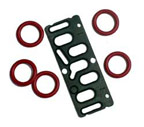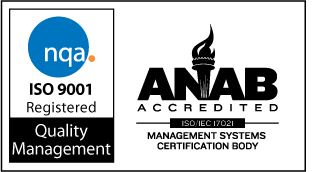Nitrile
O-ring
(Buna-N)
-40 C to +135 C
(Low-Temp)
-65 C to +120 C
Presently
this is the most widely used elastomer for an o-ring. It has
excellent resistance to petroleum based oils and fuels, silicone
greases, hydraulic fluids, water and alcohols. It has a good
balance of working properties such as low compression set, high
tensile strength, high abrasion resistance, combined with a
low cost.
Use
this elastomer with petroleum oils, water and hydraulic oils
but do not use it with brake fluid, ketones, phosphate esters,
and H2S.
Carboxilated
Nitrile O-ring
-54 C to +135 C
A
carboxilated nitrile o-ring will work at low temperatures and
has excellent abrasion resistance. It is commonly used in Downhole
applications.
Use
a carboxilated nitrile o-ring with petroleum oils and water but
do not use with brake fluid and phosphate esters.
Highly
Saturated Nitrile O-ring (HSN, HNBR)
-26 C to +160 C
Hydrogenated
Nitrile Butadiene Rubber (HNBR), also known as Highly Saturated
Nitrile (HSN), is special class of nitrile that has been hydrogenated
to increase saturation of the butadiene part of the carbon polymer.
New improvements in the material properties include greater
chemical resistance, more thermal stability and greater tensile
strength.
HNBR
is classified by ASTM as a DH-type polymer. This classification
indicates 150ºC service temperature as well as less than
30% swell in IRM 903 oil. HNBR can meet application temperatures
that are between -50°C and 165ºC.
An
HSN or HNBR nitrile o-ring has excellent resistance to petroleum
oils and sour gas. With the extended temperature range, HSN
and HNBR o-rings are becoming a preferred compound in the oil
patch.
Use
a highly saturated nitrile o-ring with petroleum oils, H2S and
CO2 and avoid using it with brake fluid.


